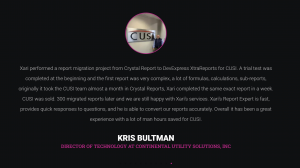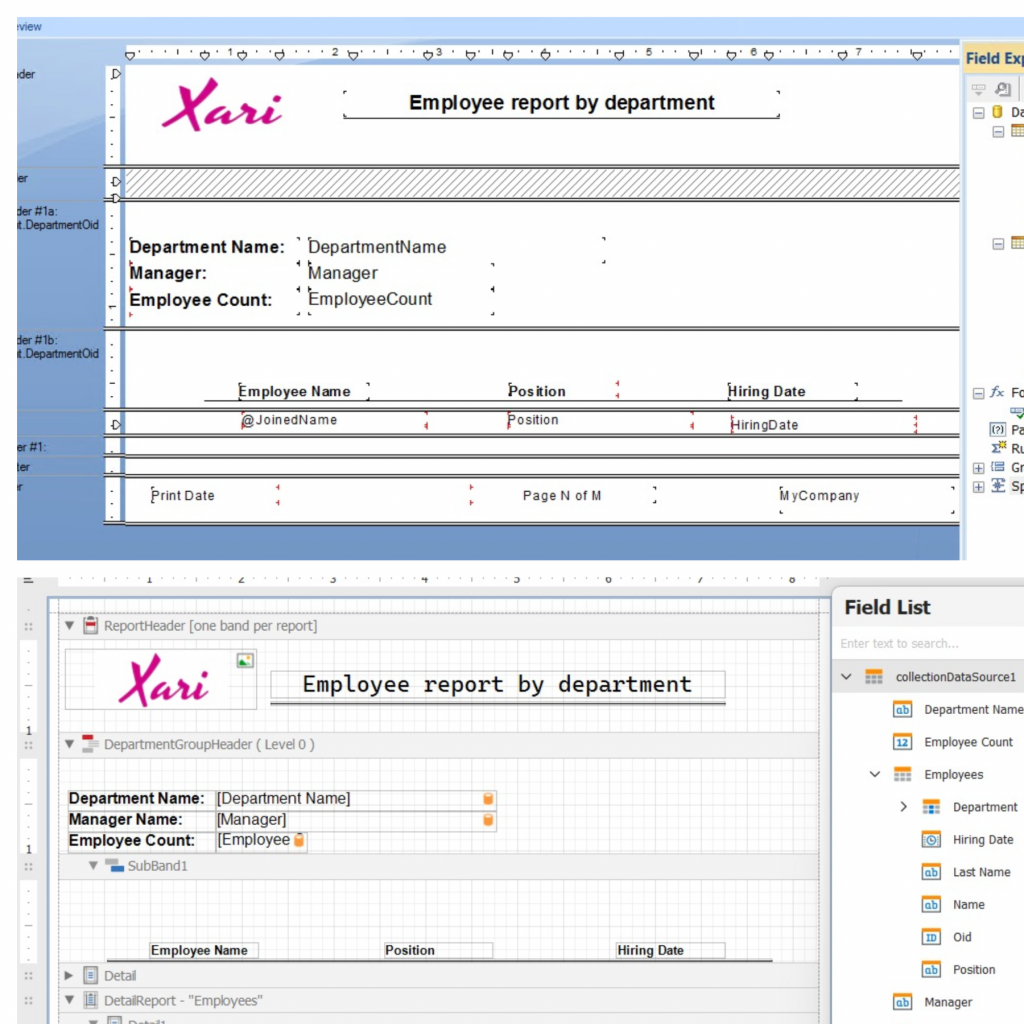Executive Summary
Organizations seeking to modernize their reporting infrastructure often face the challenge of migrating from legacy reporting tools like Crystal Reports to more contemporary solutions. This post outlines a systematic approach to migrating from Crystal Reports to DevExpress Reports, highlighting key considerations, potential challenges, and best practices to ensure a successful transition.
At Xari, our team of Reports Experts has successfully migrated thousands of reports from Crystal Reports to DevExpress, developing proprietary tools and methodologies that significantly accelerate the migration process. This article draws on our extensive experience to provide you with proven strategies for a smooth transition.
DevExpress Reports offers modern features, better integration with .NET applications, and improved performance compared to Crystal Reports. However, the migration process requires careful planning and execution to maintain report functionality and appearance while leveraging the new platform’s capabilities.
Introduction
Why Migrate from Crystal Reports?
Crystal Reports has long been an industry standard for business reporting, but organizations increasingly find themselves constrained by its limitations, including:
- Limited integration with modern .NET applications
- Challenging deployment scenarios
- Licensing complexities
- Diminishing technical support
- Performance issues with large datasets
Benefits of DevExpress Reports
DevExpress Reports addresses many of these challenges by offering:
- Seamless integration with .NET applications
- Modern user interface components
- Comprehensive developer tooling
- Flexible deployment options
- Enhanced performance and scalability
- Powerful data visualization capabilities
- Regular updates and active support
Migration Methodology
Migrating from Crystal Reports to DevExpress Reports requires a systematic approach to ensure all reports maintain their functionality and appearance. The following methodology provides a structured framework for the migration process.
1. Assessment and Preparation
Inventory Existing Reports
- Document all existing Crystal Reports, their usage, and business criticality
- Identify report complexity (simple, medium, complex) based on features used
- Prioritize reports for migration based on business importance and complexity
Infrastructure Requirements
- Install Crystal Reports v13.0+ on the conversion workstation
- Install the latest DevExpress reporting package
- Set up development, testing, and production environments
- Ensure all necessary data connections are available
2. Technical Migration Process
2.1 Report Conversion
Automated Conversion
- Create a blank DevExpress XtraReport
- Use the built-in import tool to convert the Crystal Report (.RPT file)
- For batch processing, use the Command-Line Utility:
ReportsImport /in:path\to\crystal\file.rpt /out:path\to\output\report.repx /crystal:UnrecognizedFunctionBehavior=Ignore - For large-scale migrations, Xari Reports Experts have developed proprietary tools that automate much of this process, handling hundreds of reports simultaneously while intelligently resolving common conversion issues
Data Source Migration
- Review converted data sources (converted to SqlDataSource objects)
- Choose between binding to existing data sources or creating new typed datasets
- Verify data relationships for master-detail reports
- Note that only the first SQL data source is used and assigned to the report’s DataSource property
- Be aware that data source tables from different databases are not joined automatically
2.2 Post-Conversion Enhancements
Address Conversion Limitations
- Recreate user credentials (not imported with passwords)
- Update parameter descriptions and display members
- Rebuild empty subreports, charts, and pivot grids
Fix Unsupported Functions
- Identify expressions containing “NOT_SUPPORTED” messages
- Implement equivalent functionality using DevExpress expressions
- Create custom functions where necessary.
Redesign Report Elements
- Adapt from Crystal Reports Sections to DevExpress Report Bands
- Rebuild charts and visualizations
- Recreate pivot grids with proper data binding
- Reimagine subreports using DetailReport bands
- Configure master-detail relationships appropriately
3. Parameter and Expression Handling
Parameter Configuration
- Recreate Crystal Reports parameters as DevExpress parameters
- Set appropriate parameter types and default values
- Configure parameter visibility and behavior
- Update filter expressions that use parameters
- Implement dynamic parameter lists where needed
Expression Migration
- Convert Crystal Reports formulas to DevExpress expressions
- Update data field references to use DevExpress syntax [FieldName]
- Change parameter references to use ?ParameterName syntax
- Adapt aggregate functions to use DevExpress equivalents
- Implement custom functions for complex calculations
4. Testing and Validation
Functional Testing
- Verify all data sources are correctly connected
- Confirm parameter functionality matches original report
- Test filtering, sorting, and grouping capabilities
- Validate calculations and formulas produce identical results
Visual Comparison
- Compare layouts between original and migrated reports
- Verify fonts, alignment, and spacing
- Ensure consistent pagination
- Check export functionality to various formats (PDF, Excel, etc.)
Performance Testing
- Benchmark report generation times
- Test with large datasets
- Optimize where necessary
5. Deployment and Integration
Application Integration
- Replace Crystal Reports viewer controls with DevExpress Report Viewers
- Update report generation and export code
- Implement new DevExpress-specific features as needed
User Training
- Document changes in report functionality
- Train end-users on new parameter interfaces
- Provide guidance on new features available
Common Challenges and Solutions
The Xari Reports Experts team has encountered and overcome virtually every challenge in the migration process. Our experience complex multi-level reports with nested groups and conditional sections has allowed us to develop robust solutions to common issues:
Challenge: Structural Differences
Solution: Understanding that Crystal Reports uses “Sections” while DevExpress uses “Report Bands” is crucial for successful migration. Map Crystal Report sections to appropriate DevExpress bands.
Challenge: Formula Conversion
Solution: DevExpress uses a different expression language. Create a translation table for common formulas and implement custom functions for complex calculations. Pay special attention to:
- Date manipulation functions
- String formatting
- Conditional logic
- Aggregate calculations
Challenge: Subreports and Charts
Solution: Since these elements are inserted as empty placeholders during conversion, recreate them using DevExpress’s native capabilities:
Rebuild charts using XRChart control
Implement pivot grids with proper data binding
Challenge: Data Source Management
Solution: DevExpress handles data sources differently from Crystal Reports:
- Convert complex data sources into multiple SQL data sources
- Create appropriate relationships between data tables
- Use master-detail bands to represent hierarchical data
Testimonials:

Best Practices
Document Everything: Create detailed documentation of existing reports before migration
Prioritize Reports: Focus on business-critical reports first
Create a Test Plan: Develop comprehensive test cases for each report
Establish Standards: Define coding and design standards for new reports
Incremental Migration: Convert reports in manageable batches
User Feedback: Involve end-users throughout the process
Knowledge Transfer: Train developers on DevExpress-specific features
Leverage Automation: Use specialized tools like those developed by Xari to accelerate the process
Pattern Recognition: Identify common report patterns to streamline conversion
Continuous Validation: Implement automated comparison tools to verify output consistency
Conclusion
Migrating from Crystal Reports to DevExpress Reports represents a significant opportunity for organizations to modernize their reporting infrastructure while improving performance, maintainability, and user experience. While the process involves several technical challenges, the structured approach and specialized tools developed by Xari Reports Experts can minimize risks, reduce project timelines by up to 60%, and maximize the benefits of the new platform.
About Xari Reports Experts
This post was prepared by the Xari Reports Experts team, with thousands of successful report migrations across industries including finance, healthcare, manufacturing, and government.
© 2025 | Xari Reports Experts | Enterprise Reporting Solutions


